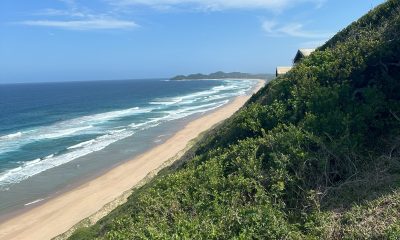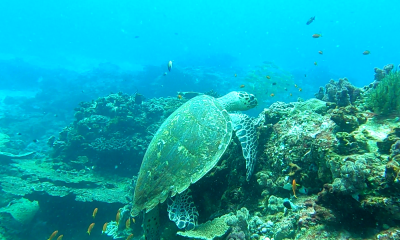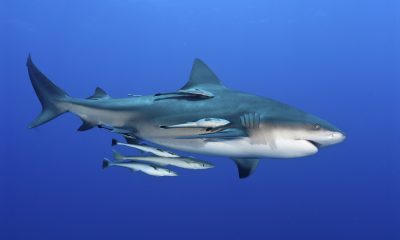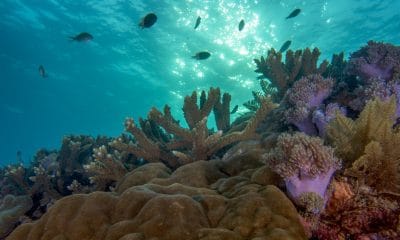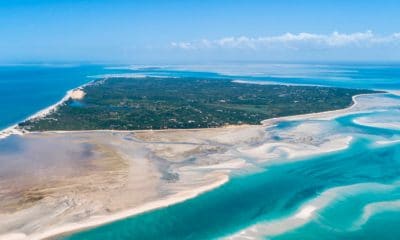Travel Stories
Diving with the Big Boys
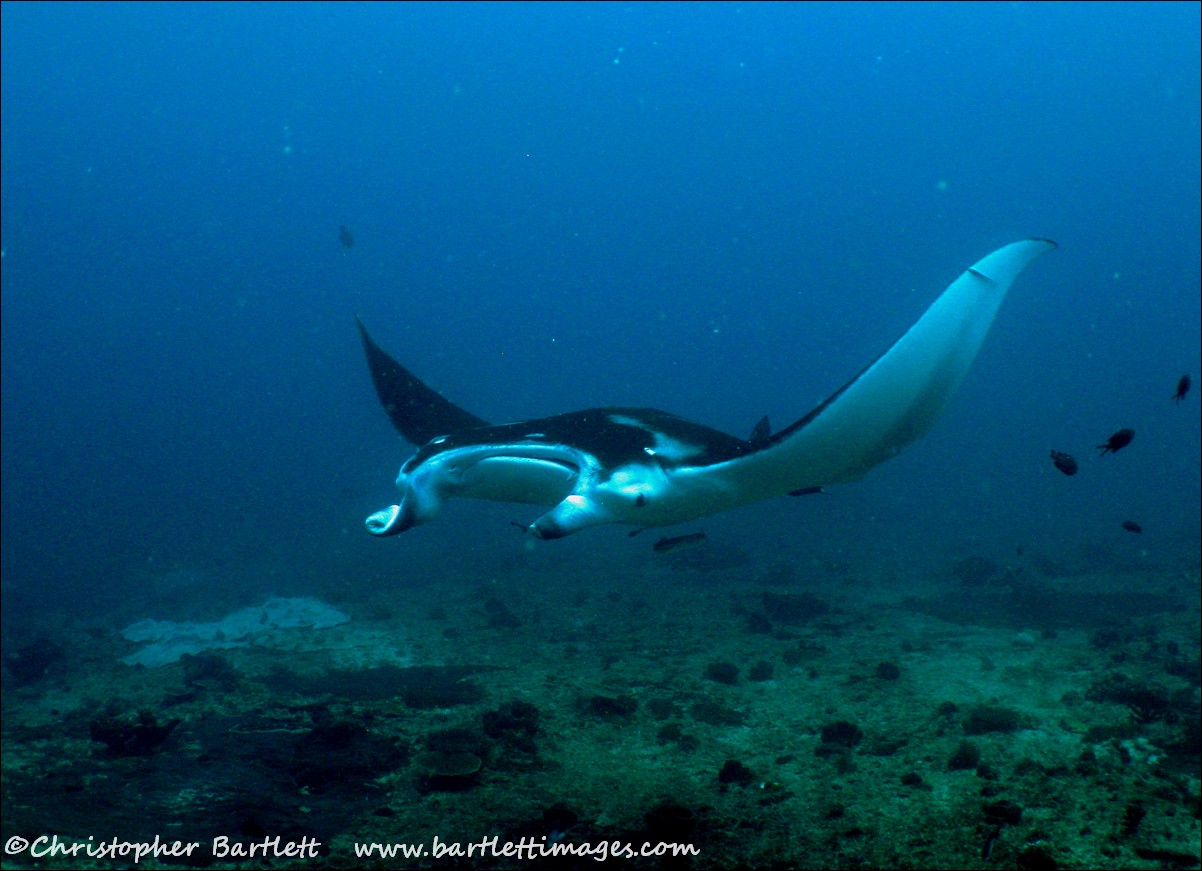
Mantas, Mantas and more Mantas…. plus a whole lot more. Christopher Bartlett visits Mozambique to experience the world class diving that the country has to offer
“Hold her straight!” shouted John over the surf. “Ladies on! Hold the nose and keep going!” he encouraged as the skipper jumped on and fired up the twin 85s. “OK, jump on!” Pulling myself along the boat from the nose until my feet touch the sand again I pushed off the bottom and heaved on the side rope, popping onto the pontoon of the RIB. “Feet in foot straps and hold on to the rope” dive guide Carlos reminded us as the RIB surged forward looking for a gap in the rolling surf.
Every launch is like this here, some days are relatively sedate, others provide more fun as the wind and swell make holding the bow like a rodeo. Personally I think surf launches are a great start to the day. Past the backline and the last breakers, we relaxed and zipped across the Indian Ocean parallel to the Mozambican dune-covered coast to our first dive site.
Rolling backwards off the pontoon of the RIB, I delighted in the slow-motion freefall from a negative entry, going straight down with Carlos. “At last” I thought, “this is the life”. Yet I had little time to contemplate the hue of the blue and the visibility, as the instant I looked down I saw a giant manta moving slowly over the cleaning station 20 metres below. It slid graciously and effortlessly through the water, butterflyfish, goldies, and wrasses nibbling it clean of the parasites it had picked up on its oceanic wanderings. We unobtrusively dropped behind a wall next to the cleaning station and watched as a second and then a third manta glided in, whilst a large green turtle settled into a hollow. What a start!
[wppa type=”slideonlyf” album=”14″ align=”center”][/wppa]
As we drifted gently along the dive site, the oddly-named Hogwarts, 100 kilos of potato grouper gave us the eye, kingfish motored past, and a school of barracuda zipped along. My grin was so wide I nearly lost my regulator when a unique small-eyed stingray, the largest of all stingrays and only ever seen alive here, 5000 kilometres from the edge of its previously considered range, flapped its two-metre wide wings and slid past nonchalantly. It was undoubtedly the best first dive of a trip ever, and there were some big smiles on the surface, dive leader Carlos beaming even more than normal.
As we closed in on the beach the novices were reminded to hold themselves down on the pontoon as the RIB was beached at high speed. Even after the 100th time it feels like a commando operation and there is a frisson of anticipation waiting for the bump as the boat leaves the sea and rides up the sloping beach to escape the breakers.
450 kilometres north of Maputo, Mozambique’s capital, and half an hour from the historic Portuguese trading town of Inhambane and it’s airport, Tofo is a laid-back village popular for its endless pristine beaches and, of course, SCUBA diving. The warm waters of the Indian Ocean provide sustenance for an abundance of marine life here, but the mantas and the whale sharks are the stars of the show.
On the boat after the first dive, the crew changed our cylinders and we moved close to the coast and started cruising slowly, looking for the biggest fish in the ocean, the beautiful and docile whale shark. Within an hour skipper Ernesto’s eagle eye picked out the outline of one of these giant planktivores. Donning fins and masks we slid over the side and snorkelled alongside a six-metre specimen, the sun’s rays highlighting the white spotted patterns that cover its body from the tip of its tail to its super-wide terminal mouth.
Attracted by the plankton blooms that occur in the vicinity, Junior opened wide to filter out the nutrients with the spongy tissue near its gill arches. As we did our best to keep up, he progressed effortlessly seemingly not moving his tail at all, staying just below the surface for 10 minutes, before he disappeared from view.
And Junior is not alone; according to research scientist and Whale Shark specialist Dr Simon Pierce, Tofo has the world’s largest population of the species, present year round, making it an ideal place for a sighting or two. Non-divers can also enjoy an amazing encounter with this behemoth on a two-hour ocean safari run by Tofo Scuba. I swam with them on four occasions in 14 days of diving. Not bad considering that seven of thise days were spent visiting sites to the north that are not in the vicinity of whale shark action.
There are three dive centres in Tofo, with similar prices, but Tofo Scuba (www.tofoscuba.co.za) has an attractive, purpose-built dive centre on the beach, a training pool, an on-site restaurant, and very professional and friendly staff. They are an eclectic mix of nationalities who make you feel at home straight away, and with smiles everywhere it is impossible to not have a good time. The rates are the best in town too: On a 10-dive package with your own equipment, a dive comes to a very reasonable 22 pounds. Some of the further reefs are subject to a small surcharge, but are well worth it.
To the north, Amazon with its strong currents has a good mix of macrolife, lionfish, honeycomb morays, and groupers, and never has it such a pleasure to be informed that it is time to go to The Office. Michael Scott was happily absent but his chair is often filled by a leopard shark, some whitetips, and the wierdly beautiful bowmouth guitarfish. Colosseum is another northern site and has only ever been dived a handful of times but should be renamed The Hospital for its schools of eye-stripe surgeonfish.
Straight out of the bay lies Giant’s Castle. Dropping next to a Manta cleaning station, we drifted along the battlements as spectre-like silhouettes appeared from the blue, before dropping down to find the crawling sea moth or short dragonfish, morays, and ribbon eels. Often the second dive of the day, it has a relatively short bottom time despite a 90-minute surface interval, but it’s an action packed half-hour. As the bottom sloped downwards, peppered with green coral trees, a large school of pelagic big-eye jacks cruised into view circling us for a minute, and as we rose to our safety stop a school of devil rays ambled past. Giant’s also seems to be a favourite haunt of the small-eye stingray and I was fortunate enough to see it there on two occasions.
To the south, next to the impressive Hogwarts, lies the jewel in Tofo’s crown. The aptly-named Manta Reef is a vibrant piece of underwater eye candy that I would happily dive over and over. From the surface swathes of yellow and striped snapper, red soldierfish, and blue red-fang triggerfish covering the pinnacles can be seen. Dropping into an ampitheatre that starts at 18 metres and bottoms out at 28, it is impossible to know where to look. Whilst taking in the stunning colours of the schooling fish, my eye is caught by a coral whip goby, and then I spy African and Potato Grouper under different overhangs. Back over the edge of the wide bowl, countless mantas (the resident and world-leading manta researcher Dr Andrea Marshall identified 22 different individuals there the previous day), both giant and “normal”, glided gracefully over the numerous cleaning stations, as a myriad of goldies, damsels, and butterflyfish picked them clean. They danced over us, around us, and even between us, as if courting each other. I was certainly smitten. And that was before meeting the monster.
I have seen many a fair-sized giant moray, as thick as a large man’s head, but, standing proudly on one-third of its three metres at the back of a cave like a dragon in its lair, was a beast with a head the size of a horse. Unsurprisingly I could not convince my buddy to go in with a torch to help me focus my camera and give a sense of scale, but the image of this goliath of morays will stay with me until I return, as return I will. Manta Reef is definitely up there with the best.
Tofo has a range of accommodation options from camping to lodges, but right next to the dive centre the independently owned and run Aquaticos Beachside Casitas provide conveniently located, good value for money self-catering with friendly staff who take care of dishwashing and free laundry to boot. A short walk along the beach or sand roads to the market and several restaurants and bars, and an even shorter walk to Tofo on-line for email junkies, or to Dino’s bar for pizza or prawns, everything is close by. Meals at Tofo Scuba, Dino’s, or Fatima’s go for around 8 USD, a pizza will set you back 10 USD. Coraciida is a new place on the other side of the dive shop that costs 72 euros per double per night and Casa do Mar in the centre of the village is arguably the most upmarket place to stay and a double costs $160 USD per night for the room.
The market has fresh fruit and veg, cashews, fish, and basic groceries, and, hidden in the centre behind the colourful batiks, some local lunch eateries serving rice with fish, chicken, or beef cooked on coals for a dollar fifty. If your Portugese or Bitongo isn’t up to much, pointing at a pot and saying “que es, por favor?” will get you a look inside. In the evening ask for Mr Bamboo’s for grilled chicken or fish with a mountain of rice and fresh tomato salsa and wash it down with a 500 ml Manica, a Dois M, or Mozambique’s stout, Laurentina Preta, and you’ll get change from five USD.
It’s perfectly safe to walk around day or night, and the curiously squeeky sand is a delight to stroll along. Just remember to pack the sunscreen, as even in early May the air temperature is in the low thirties, and the sea at 25-27C, although it can drop to the low twenties in July.
As I write this in the bus heading south, taking in the palm trees, acacias, and the villages with cassava crops and roadside vendors, I wonder when I’ll be back. Tofo and its megafauna have enchanted me.
LAM fly between Inhambane and Johannesburg on Mondays, Wednesdays, Fridays, and Sundays, or it’s an eight-hour ride on a shuttle bus departing from outside Fatima’s in Maputo at 5 a.m everyday. The cost is around 16 USD and there is more information at www.mozambiquebackpackers.com. The LAM ticket office is difficult to deal with and it’s best to go through an agent like Indigo Safaris www.indigosafaris.com. They deal with a range of accommodation providers in Tofo and can build in a land safari in the Kruger National Park in South Africa too. A Johannesburg-Inhambane return is around 500 to 600 USD.
Blogs
Northern Red Sea Reefs and Wrecks Trip Report, Part 3: The Mighty Thistlegorm

Jake Davies boards Ghazala Explorer for an unforgettable Red Sea diving experience…
Overnight, the wind picked up, making the planned morning dive a bit bumpy on the Zodiacs to the drop point on Thomas Reef. There, we would dive along the reef before descending through the canyon and then passing under the arch before ascending the wall with a gentle drift. The site provided great encounters with more pelagic species, including shoals of large barracuda, tuna, and bigeye trevally.
Once back on the boat, it was time to get everything tied down again as we would head back south. This time, with the wind behind us, heading to Ras Mohammed to dive Jackfish Alley for another great gentle drift wall dive before then heading up the coast towards the Gulf of Suez to moor up at the wreck of the Thistlegorm. This being the highlight wreck dive of the trip and for many onboard, including myself, it was the first time diving this iconic wreck. I had heard so much about the wreck from friends, and globally, this is a must on any diver’s list. Fortunately for us, there was only one other boat at the site, which was a rarity. A great briefing was delivered by Ahmed, who provided a detailed background about the wreck’s history along with all the required safety information as the currents and visibility at the site can be variable.

Kitting up, there was a lot of excitement on deck before entering the water and heading down the shoreline. Descending to the wreck, there was a light northerly current which reduced the visibility, making it feel more like the conditions that can be found off the Welsh coast. At 10m from the bottom, the outline of the wreck appeared as we reached the area of the wreck which had been bombed, as our mooring line was attached to part of the propeller shaft. Arriving on deck, instantly everywhere you looked there were many of the supplies which the ship was carrying, including Bren Carrier tanks and projectiles that instantly stood out.

We headed around the exterior, taking a look at the large propeller and guns mounted on deck before entering the wreck on the port side to take a look in the holds. It was incredible to see all the trucks, Norton 16H, and BSA motorcycles still perfectly stacked within, providing a real snapshot in time.

Overall, we had four dives on the Thistlegorm, where for all of the dives we were the only group in the water, and at times, there were just three of us on the whole wreck, which made it even more special, especially knowing that most days the wreck has hundreds of divers. Along with the history of the wreck, there was plenty of marine life on the wreck and around, from big green turtles to batfish, along with shoals of mackerel being hunted by trevally. Some unforgettable dives.

The final leg of the trip saw us cross back over the Suez Canal to the Gobal Islands where we planned to stay the night and do three dives at the Dolphin House for the potential of sharing the dive with dolphins. The site, which included a channel that was teeming with reef fish, especially large numbers of goatfish that swam in large shoals along the edge of the reef. These were nice relaxing dives to end the week. Unfortunately, the dolphins didn’t show up, which was okay as like all marine life they are difficult to predict and you can’t guarantee what’s going to be seen. With the last dive complete, we headed back to port for the final night where it was time to clean all the kit and pack before the departure flight the next day.

The whole week from start to finish on Ghazala Explorer was amazing; the boat had all the facilities you need for a comfortable week aboard. The crew were always there to help throughout the day and the chefs providing top quality food which was required after every dive. The itinerary providing some of the best diving with a nice mixture of wreck and reef dives. I would recommend the trip to anyone, whether it’s your first Red Sea liveaboard in the Red Sea or you’re revisiting. Hopefully, it’s not too long before I head back to explore more of the Red Sea onboard Ghazala Explorer.

To find out more about the Northern Red Sea reef and wrecks itineraries aboard Ghazala Explorer, or to book, contact Scuba Travel now:
Email: dive@scubatravel.com
Tel: +44 (0)1483 411590
Photos: Jake Davies / Avalon.Red
Blogs
Northern Red Sea Reefs and Wrecks Trip Report, Part 2: Wall to Wall Wrecks

Jake Davies boards Ghazala Explorer for an unforgettable Red Sea diving experience…
The second day’s diving was a day full of wreck diving at Abu Nuhas, which included the Chrisoula K, Carnatic, and Ghiannis D. The first dive of the day was onto the Chrisoula K, also known as the wreck of tiles. The 98m vessel remains largely intact where she was loaded with tiles which can be seen throughout the hold. The stern sits at 26m and the bow just below the surface. One of the highlights of the wreck is heading inside and seeing the workroom where the machinery used for cutting the tiles are perfectly intact. The bow provided some relaxing scenery as the bright sunlight highlighted the colours of the soft coral reef and the many reef fish.

Following breakfast, we then headed to the next wreck, which was the Carnatic. The Carnatic is an 89.9m sail steamer vessel that was built in Britain back in 1862. She ran aground on the reef back in 1869 and remains at 27m. At the time, she was carrying a range of items, including 40,000 sterling in gold. An impressive wreck where much of the superstructure remains, and the two large masts lay on the seafloor. The wooden ribs of the hull provide structures for lots of soft corals, and into the stern section, the light beams through, bouncing off the large shoals of glass fish that can be found using the structure as shelter from the larger predators that are found outside of the wreck.

The final wreck at Abu Nuhas was the Ghiannis D, originally called ‘Shoyo Maru,’ which was 99.5m long and built in Japan back in 1969 before becoming a Greek-registered cargo ship in 1980. The ship then ran aground on the reef on April 19th, 1983, and now sits at the bottom at a depth of 27m. Heading down the line, the stern of the ship remains in good condition compared to the rest of the hull. The highlight of the wreck, though, is heading into the stern section and down the flights of stairs to enter the engine room, which remains in good condition and is definitely worth exploring. After exploring the interior section of the ship, we then headed over to see the rest of the superstructure, where it’s particularly interesting to see the large table corals that have grown at the bow relatively quickly considering the date the ship sank. After surfacing and enjoying some afternoon snacks, we made sure everything was strapped down and secured as we would be heading north and crossing the Gulf of Suez, where the winds were still creating plenty of chop.

The next morning, it was a short hop to Ras Mohammed Nature Reserve for the next couple of days of diving. The 6am wake-up call came along with the briefing for the first site we would be diving, which was Shark & Yolanda. The low current conditions allowed us to start the dive at Anemone City, where we would drift along the steep, coral-filled wall. These dives involved drifts, as mooring in Ras Mohammed wasn’t allowed to protect the reefs. As a dive site, Shark & Yolanda is well-known and historically had a lot of sharks, but unfortunately not so many in recent years, especially not so early in the season. However, there was always a chance when looking out into the blue.

The gentle drift took us along the steep walls of the site, with plenty of anemone fish to be seen and a huge variety of corals. It wasn’t long into the dive before we were accompanied by a hawksbill turtle, who drifted with us between the two atolls before parting ways. Between the two reefs, the shallow patch with parts of coral heads surrounded by sand provided the chance to see a few blue-spotted stingrays that were mainly resting underneath the corals and are always a pleasure to see. With this being the morning dive, the early sunlight lit up the walls, providing tranquil moments. Looking out into the blue, there was very little to be seen, but a small shoal of batfish shimmering underneath the sunlight was a moment to capture as we watched them swim by as they watched us.

Towards the end of the dive, we stopped at the wreck of the Jolanda where the seafloor was scattered with toilets from the containers it was carrying. This provided a unique site to make a safety stop, which was also accompanied by a large barracuda slowly swimming by, along with a hawksbill turtle calmly swimming over the reef as the sun rays danced in the distance.
For the next dive, we headed north to the Strait of Tiran to explore the reefs situated between Tiran Island and Sharm El Sheik, which were named after the British divers who had found them. We started on Jackson before heading to Gordons Reef, where we also did the night dive. All the atolls at these sites provided stunning, bustling coral reefs close to the surface and steep walls to swim along, which always provided the opportunity to keep an eye out for some of the larger species that can be seen in the blue. Midwater around Jackson Reef was filled with red-toothed triggerfish and shoals of banner fish, which at times were so dense that you couldn’t see into the blue. Moments went by peacefully as we enjoyed the slow drift above the reef, watching these shoals swim around under the mid-afternoon sun.

The night dive at Gordon’s Reef was mainly among the stacks of corals surrounded by sand, which was great to explore under the darkness. After some time circling the corals, we came across what we were really hoping to find, and that was an octopus hunting on the reef. We spent the majority of the dive just watching it crawl among the reef, blending into its changing surroundings through changes in colour and skin texture. It’s always so fascinating and captivating to watch these incredibly intelligent animals, in awe of their ability to carry out these physical changes to perfectly blend into the reef. Before we knew it, it was time to head back to the boat to enjoy a well-deserved tasty dinner prepared by the talented chefs onboard.
Check in for the 3rd and final part of this series from Jake tomorrow!
To find out more about the Northern Red Sea reef and wrecks itineraries aboard Ghazala Explorer, or to book, contact Scuba Travel now:
Email: dive@scubatravel.com
Tel: +44 (0)1483 411590
Photos: Jake Davies / Avalon.Red
-

 News3 months ago
News3 months agoHone your underwater photography skills with Alphamarine Photography at Red Sea Diving Safari in March
-

 News3 months ago
News3 months agoCapturing Critters in Lembeh Underwater Photography Workshop 2024: Event Roundup
-

 Marine Life & Conservation Blogs3 months ago
Marine Life & Conservation Blogs3 months agoCreature Feature: Swell Sharks
-

 Blogs2 months ago
Blogs2 months agoMurex Resorts: Passport to Paradise!
-

 Blogs2 months ago
Blogs2 months agoDiver Discovering Whale Skeletons Beneath Ice Judged World’s Best Underwater Photograph
-

 Gear Reviews2 weeks ago
Gear Reviews2 weeks agoGEAR REVIEW – Revolutionising Diving Comfort: The Sharkskin T2 Chillproof Suit
-

 Marine Life & Conservation2 months ago
Marine Life & Conservation2 months agoSave the Manatee Club launches brand new webcams at Silver Springs State Park, Florida
-

 Gear Reviews3 months ago
Gear Reviews3 months agoGear Review: Oceanic+ Dive Housing for iPhone



